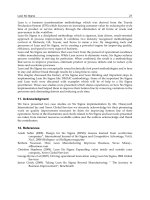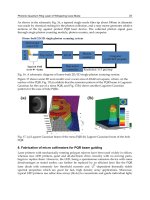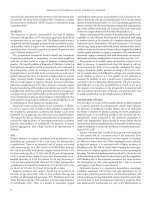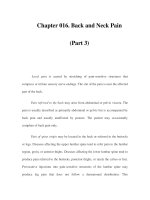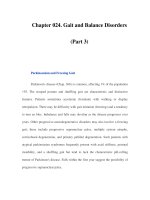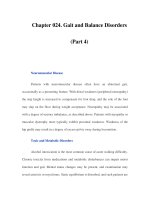Chapter 025. Numbness, Tingling, and Sensory Loss (Part 3) pptx
Bạn đang xem bản rút gọn của tài liệu. Xem và tải ngay bản đầy đủ của tài liệu tại đây (57.83 KB, 5 trang )
Chapter 025. Numbness, Tingling,
and Sensory Loss
(Part 3)
Examination of Sensation
The main components of the sensory examination are tests of primary
sensation (pain, touch, vibration, joint position, and thermal sensation; Table 25-
1).
Table 25-1 Testing Primary Sensation
Sense Test
Device
Endings
Activated
Fib
er Size
Mediatin
g
Cent
ral
Pathway
Pain Pinpr
ick
Cutaneous
nociceptors
Sm
all
SpTh
, also D
Temperat
ure, heat
War
m metal
object
Cutaneous
thermoreceptors for
hot
Sm
all
SpTh
Temperat
ure, cold
Cold
metal object
Cutaneous
thermoreceptors for
cold
Sm
all
SpTh
Touch Cotto
n wisp, fine
brush
Cutaneous
mechanoreceptors,
also naked endings
Lar
ge and
small
Lem,
also D and
SpTh
Vibration Tuni
ng fork, 128
Hz
Mechanorecep
tors, especially
pacinian corpuscles
Lar
ge
Lem,
also D
Joint Passi
ve
Joint capsule
and tendon endings,
Lar Lem,
position movement
of specific
joints
muscle spindles ge also D
Note: D, diffuse ascending projections in ipsilateral and contralateral
anterolateral columns; SpTh, spinothalamic projection, contralateral; Lem,
posterior column and lemniscal projection, ipsilateral.Some general principles
pertain. The examiner must depend on patient responses, particularly when testing
cutaneous sensation (pin, touch, warm, or cold), which complicates interpretation.
Further, examination may be limited in some patients. In a stuporous patient, for
example, sensory examination is reduced to observing the briskness of withdrawal
in response to a pinch or other noxious stimulus. Comparison of response on one
side of the body to the other is essential. In the alert but uncooperative patient, it
may not be possible to examine cutaneous sensation, but some idea of
proprioceptive function may be gained by noting the patient's best performance of
movements requiring balance and precision. Frequently, patients present with
sensory symptoms that do not fit an anatomic localization and that are
accompanied by either no abnormalities or gross inconsistencies on examination.
The examiner should then consider whether the sensory symptoms are a disguised
request for help with psychological or situational problems. Discretion must be
used in pursuing this possibility. Finally, sensory examination of a patient who has
no neurologic complaints can be brief and consist of pinprick, touch, and vibration
testing in the hands and feet plus evaluation of stance and gait, including the
Romberg maneuver. Evaluation of stance and gait also tests the integrity of motor
and cerebellar systems.
PRIMARY SENSATION
(See Table 25-1) The sense of pain is usually tested with a clean pin, asking
the patient to focus on the pricking or unpleasant quality of the stimulus and not
just the pressure or touch sensation elicited. Areas of hypalgesia should be mapped
by proceeding radially from the most hypalgesic site (Figs. 25-2 and 25-3).Figure
25-2


